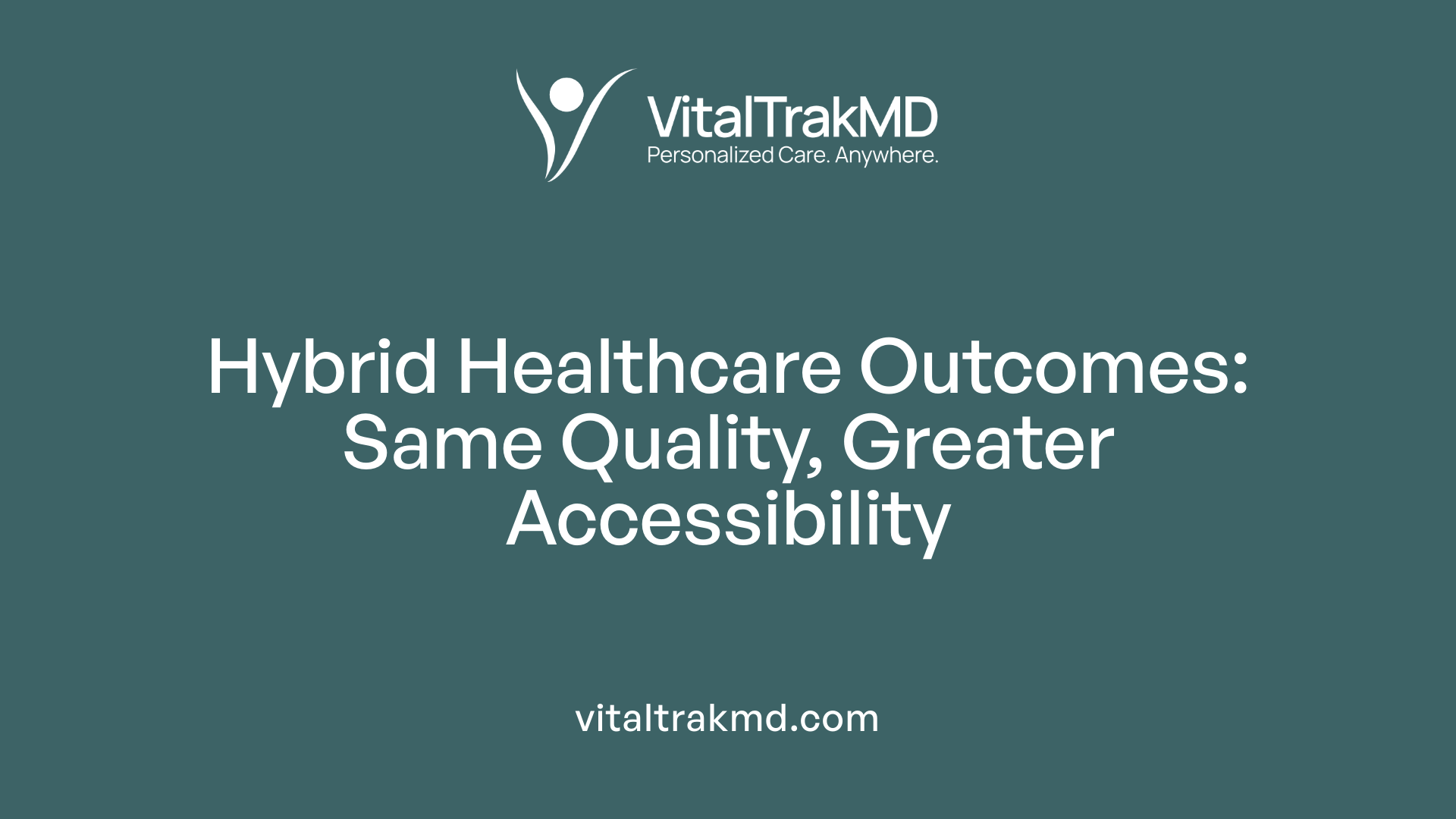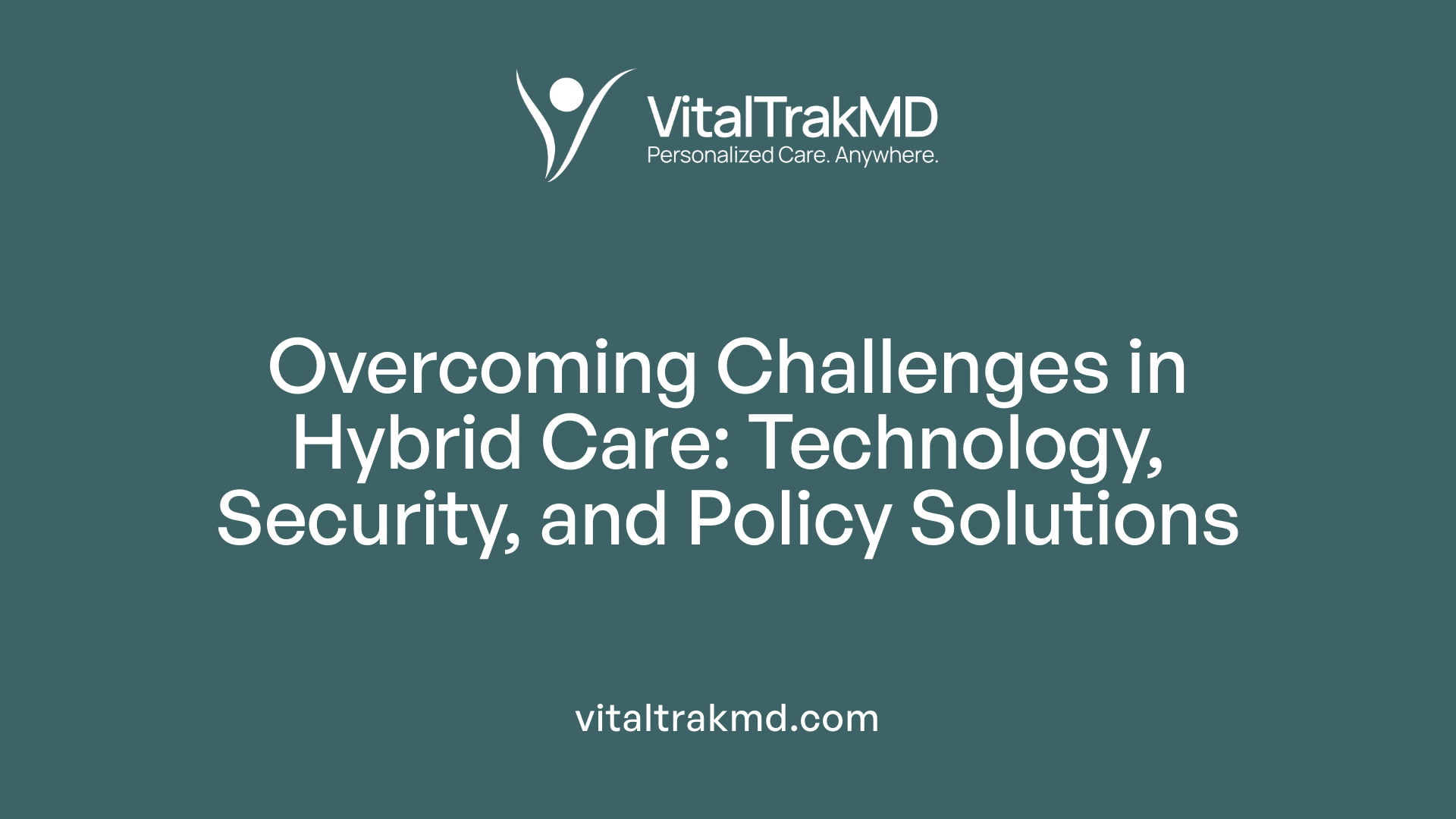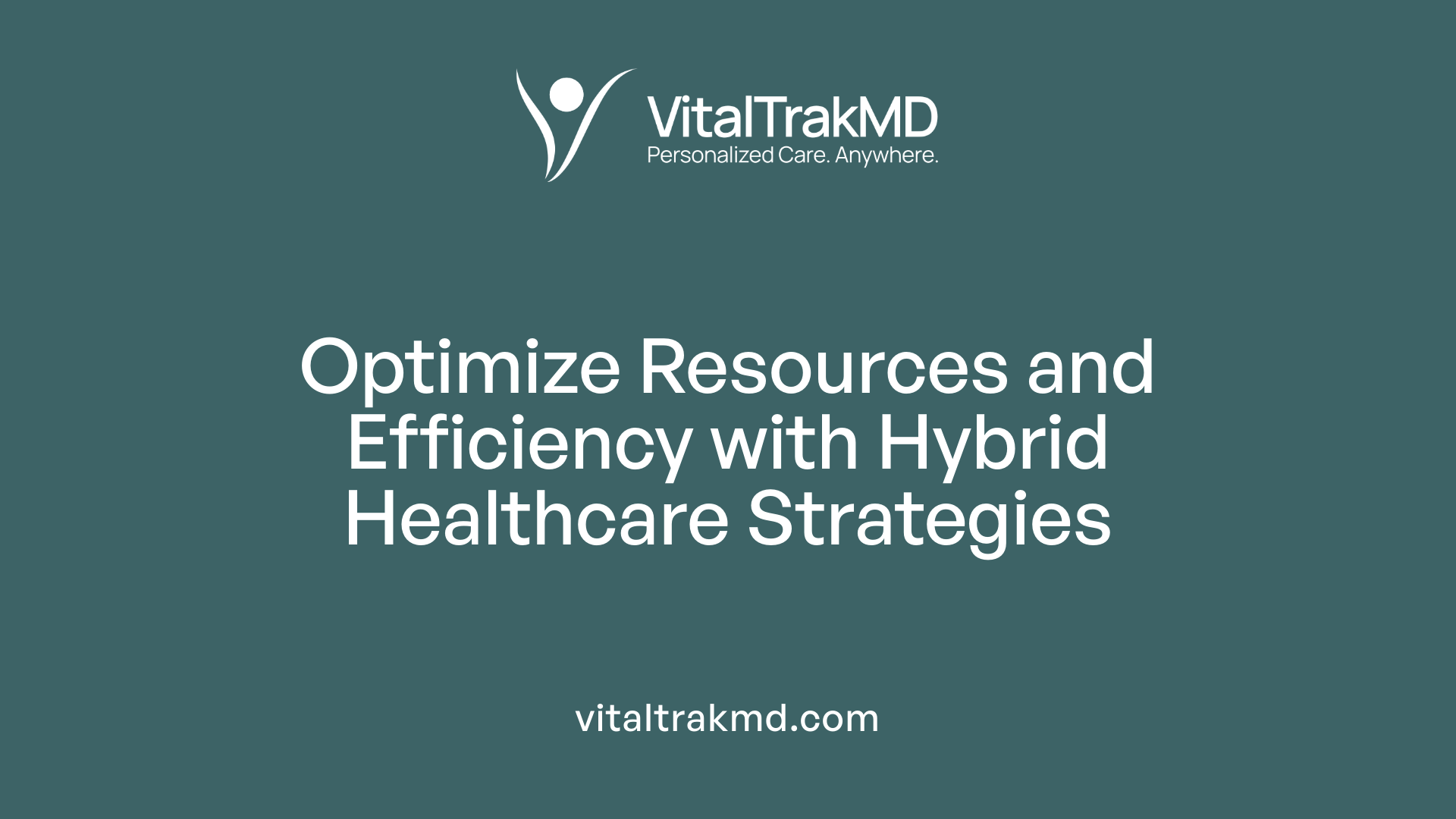Comparing Hybrid Healthcare to Traditional In-Person Care Models

Understanding the Shift from Traditional to Hybrid Care Models
The landscape of healthcare delivery is undergoing a profound transformation driven by technological advances, patient preferences, and unprecedented global health challenges like the COVID-19 pandemic. Hybrid healthcare models, which blend remote digital services with in-person care, are emerging as a promising approach to enhance access, efficiency, and quality. This article explores the multifaceted aspects of hybrid care, from clinical outcomes and operational efficiencies to policy considerations and future developments, providing a comprehensive comparison with traditional in-person care models.
Types of Healthcare Delivery Models and The Rise of Hybrid Care

What are the main types of healthcare delivery models?
The primary healthcare models include the Beveridge Model, Bismarck Model, National Health Insurance Model, and Out-of-Pocket Model.
The Beveridge Model is government-funded and universally accessible, exemplified by systems in the UK and New Zealand. It features healthcare providers employed by the government, ensuring broad coverage.
The Bismarck Model relies on non-profit insurance funds financed through payroll deductions, with most providers in the private sector. Countries such as Germany and Japan adopt this approach.
The National Health Insurance Model combines government-funded insurance with private providers, seen in Canada and South Korea. It aims to balance public funding with private sector participation.
In many low-income nations, the Out-of-Pocket Model prevails, where individuals pay directly for healthcare services due to limited public infrastructure.
Growth of hybrid healthcare post-pandemic
The COVID-19 pandemic dramatically accelerated the adoption of hybrid healthcare—a blend of virtual and in-person services. Before the pandemic, telehealth usage was minimal, but during the crisis, it surged by over 766%, with more than 45 million Medicare visits in 2020 conducted virtually.
Post-pandemic, hybrid care models have maintained their relevance, integrating telehealth into routine practices. Patients value the convenience, reduced travel, and quicker access to care that hybrid systems provide.
Healthcare providers have embraced this shift, recognizing that combining digital and physical care improves efficiency, patient satisfaction, and access—especially for those in remote or underserved areas.
Integration of virtual and physical services
Hybrid healthcare seamlessly merges virtual consultations, remote monitoring, and traditional in-person visits. Technologies like video conferencing, wearable devices, and digital health platforms enable continuous patient engagement.
Programs such as Sheba Medical Center’s 'Sheba Beyond' in Israel exemplify this integration by offering hospital and home-based care through virtual beds, telemedicine, and remote monitoring. These models expand hospital capacity, reduce costs, and enhance patient satisfaction.
To implement effective hybrid systems, health systems invest in infrastructure, staff training, and standardized protocols. The focus remains on safe, high-quality care that adapts to individual patient needs.
This integrated approach not only optimizes resource utilization but also increases healthcare resilience during crises, exemplified by the pandemic response. As technology advances and healthcare landscapes evolve, hybrid models are set to become a standard in delivering equitable, efficient, and patient-centered care.
Benefits of Hybrid Healthcare over Traditional Care

What are the benefits of hybrid healthcare models compared to traditional in-person care?
Hybrid healthcare combines the best aspects of both virtual and in-person care, offering several advantages over traditional healthcare models. One of the most significant benefits is enhanced access and convenience for patients. For individuals in rural or remote areas, or those with mobility challenges, virtual visits eliminate the need for long travel, reducing time and transportation burdens.
Moreover, hybrid models improve the continuity and coordination of care. They allow seamless integration of virtual consultations, remote monitoring, and physical visits, which helps ensure that patients receive timely interventions and consistent management of chronic conditions. This integrated approach often leads to better health outcomes and higher patient satisfaction.
Flexibility and personalization are also notable benefits. Patients can choose the most appropriate care setting based on their current health status and personal preferences. For example, routine follow-ups can be conducted virtually, while in-person visits are reserved for physical exams or procedures requiring direct physical interaction. This customization supports a more patient-centered approach.
From a system perspective, hybrid healthcare enhances resilience especially during crises like pandemics. It helps manage patient surges, reduces hospital overcrowding, and maintains essential healthcare services without disruption. Additionally, it can significantly lower healthcare costs by decreasing unnecessary hospital admissions, readmissions, and facility use.
Workflow efficiencies are further increased through digital tools such as online scheduling, automated reminders, and telehealth platforms. These streamline patient-provider interactions, reduce wait times, and optimize resource utilization.
Overall, hybrid healthcare models offer a flexible, efficient, and patient-centered approach that addresses many limitations of traditional models. They support personalized care, improve access, and strengthen the healthcare system’s capacity to respond to various clinical and logistical challenges.
The Critical Role of Telehealth in Modern Healthcare

What is the role of telehealth and virtual services in modern healthcare delivery?
Telehealth and virtual services have become fundamental components of contemporary healthcare systems. Their primary function is to expand access, especially for populations in remote, underserved, or rural areas where traditional in-person care may be limited or difficult to access.
During the COVID-19 pandemic, the adoption of telehealth surged dramatically. Estimates show a rise from 14% of outpatient visits before 2019 to as high as 90% during peak pandemic periods. This shift was driven by the need to minimize infection risk and maintain continuity of care.
The scope of telehealth includes remote consultations, where patients connect with healthcare providers via video or phone calls, and remote monitoring using digital devices such as blood glucose trackers or heart rate monitors. These tools allow for ongoing management of chronic conditions like diabetes and hypertension, improving health outcomes.
Furthermore, telehealth provides mental health support, medication management, and follow-up care, reducing the need for physical visits. It also supports self-management, empowering patients to participate actively in their health.
In terms of efficiency, telehealth reduces travel time and costs for patients, decreases congestion in healthcare facilities, and can decrease the burden on hospital resources. For providers, it offers flexible scheduling and the ability to reach more patients in less time.
Despite these benefits, telehealth faces challenges including technological disparities, regulatory barriers, and concerns about privacy and data security. Connectivity issues and digital literacy gaps mean not all patients can equally benefit, highlighting the need for continued investments in infrastructure and policy reform.
Overall, telehealth and virtual services are transforming healthcare delivery by making it more accessible, timely, and patient-centered. They complement traditional care models and hold promise for a more resilient and efficient future healthcare system.
Person-Centered Care: Moving Beyond Conventional Models

How does person-centered care differ from traditional healthcare models?
Traditional healthcare models mainly focus on diagnosing and treating specific medical conditions. They are often characterized by brief, task-oriented visits that follow standardized protocols, with the healthcare provider making decisions for the patient. This approach can sometimes overlook the patient's social, emotional, mental, and spiritual needs, as well as their personal preferences.
In contrast, person-centered care adopts a holistic view of health and well-being. It emphasizes actively involving the patient in all aspects of their care, recognizing them as a whole person rather than just a set of symptoms or diagnoses. This model fosters ongoing relationships between patients and providers, encouraging shared decision-making and empowering individuals to take an active role in managing their health.
Person-centered care takes into account a person's life circumstances, values, and broader social factors. For example, especially for chronic disease management, it considers the individual's environment, support systems, and personal goals. As a result, care plans are tailored and flexible, emphasizing long-term support, trust, and respect.
Research shows that this approach can lead to better health outcomes, increased patient satisfaction, and higher levels of trust in healthcare providers. Moving beyond traditional models, person-centered care respects human rights, addresses the full spectrum of determinants affecting health, and promotes a more humane, effective, and equitable healthcare system.
How does this approach promote holistic well-being?
Active patient involvement and coordination are vital components of person-centered care. Patients are encouraged to share their preferences and participate in decision-making, which increases adherence to treatment and fosters a sense of control.
Healthcare teams collaborate closely, integrating medical and social services. This collaboration improves communication, reduces fragmentation, and ensures that care aligns with the patient's daily life and values.
What is the impact on health outcomes and trust?
By focusing on the individual's comprehensive needs and life context, person-centered care enhances trust, which is crucial for effective healthcare. Patients who feel heard and respected are more likely to engage openly with their providers and follow through with recommended treatments.
Studies indicate that person-centered approaches can decrease hospital readmissions, improve mental health, and enhance quality of life. Ultimately, moving beyond traditional models to prioritize the person as a whole leads to a more compassionate and successful healthcare experience.
| Aspect | Traditional Model | Person-Centered Care | Impact |
|---|---|---|---|
| Focus | Diagnoses, symptoms | Whole person, holistic needs | Improved health outcomes and satisfaction |
| Decision-Making | Provider-led | Shared, active patient involvement | Increased trust and adherence |
| Time Spent | Task-oriented, brief | Continuous, relationship-based | Better trust and engagement |
| Approach | Disease-focused | People-focused | More personalized and effective care |
Clinical Outcomes and Effectiveness of Hybrid Healthcare

What are the clinical outcomes and effectiveness of hybrid healthcare compared to in-person care?
Research indicates that hybrid healthcare models can achieve clinical outcomes similar to those of traditional in-person care. This approach integrates telehealth with face-to-face visits, allowing healthcare providers to deliver comprehensive and continuous care.
In studies involving older adults, hybrid visits have been shown to enhance access without compromising quality. For example, during the COVID-19 pandemic, hybrid models helped maintain high satisfaction rates and safety, especially for patients with chronic conditions. Enhanced care coordination and remote monitoring contribute to effective disease management and reduce hospitalizations.
A notable trial involving patients with advanced lung cancer used the Functional Assessment of Cancer Therapy-Lung (FACT-L) questionnaire, showing telehealth and in-person palliative care were equally effective in elevating quality of life. This illustrates that hybrid care can sustain therapeutic outcomes in complex cases.
For populations with chronic illnesses such as diabetes or hypertension, hybrid models facilitate better medication adherence, improved patient engagement, and ongoing monitoring. Patients benefit from the convenience of virtual follow-ups combined with periodic physical assessments, leading to improved health control.
The flexibility of hybrid models also supports timely intervention, reducing the risk of complications or worsening conditions. As a result, evidence supports that hybrid healthcare can match traditional care in clinical safety and efficacy, while offering greater accessibility and personalized management.
Impact on chronic and acute conditions
Hybrid healthcare has shown promising results for managing both chronic and acute health issues. For chronic disease management, remote monitoring tools and teleconsultations enable continuous oversight, leading to reductions in hospital readmissions and emergency visits. For example, in home-based care settings, hybrid models reduced 30- and 60-day hospitalizations by approximately 6-4%, respectively, and improved medication management and mobility.
In acute care scenarios, hybrid systems allow for earlier injury or illness assessment and ensure swift escalation to in-person treatment when necessary. Virtual check-ins can effectively identify escalating symptoms early, thereby preventing hospital admissions or complications.
This model also supports post-acute care, with hybrid approaches enabling seamless transitions from hospital to home, maintaining recovery progress, and supporting patient independence.
Patient satisfaction and safety
Patients generally report high satisfaction with hybrid healthcare, citing increased convenience, reduced travel burden, and continuous access to care. Surveys reveal that about 82% of individuals experienced better overall satisfaction with hybrid models, appreciating the balance of remote and in-person interactions.
Safety outcomes are comparable to traditional care, provided that appropriate protocols, digital tools, and trained personnel are in place. Studies show no significant increase in adverse events or safety concerns attributable to hybrid care.
However, some challenges include technical barriers, such as internet access and device usability, which may affect certain populations, particularly older adults or those in underserved areas. Ensuring robustness of digital infrastructure and providing technical support are essential to maximize safety and satisfaction.
Overall, the growing evidence underscores hybrid healthcare as a viable, effective approach that aligns with the goal of delivering safe, high-quality patient-centered care.
Challenges and Limitations of Hybrid Care Models

What challenges and limitations are associated with hybrid healthcare models?
Hybrid healthcare models, which blend in-person and digital medical services, offer many benefits but also face several challenges. One major hurdle involves technological barriers. Some healthcare settings lack the proper infrastructure, such as reliable internet connections or compatible systems, making the seamless integration of virtual tools difficult. Furthermore, system interoperability issues can hinder effective data sharing among various digital platforms.
Another significant concern relates to the digital divide. Not all patients have equal access to the necessary technology, including high-speed internet or remote monitoring devices, often due to socioeconomic factors or living in rural areas. This disparity can limit the effectiveness of hybrid models and potentially widen healthcare inequalities.
Data security and privacy are also prominent issues. As more health information is stored and transmitted digitally, safeguarding sensitive patient data becomes critical. Robust cybersecurity measures are needed to prevent breaches and maintain patient trust.
Organizational and workforce hurdles pose additional challenges. Implementing hybrid models requires extensive staff training and change management to adapt workflows efficiently. Resistance from healthcare workers and increased workloads may lead to burnout, especially in specialties like mental health, where hybrid work environments can feel isolating.
Regulatory and policy barriers can further complicate hybrid healthcare expansion. Existing regulations may not fully support remote care modalities, and variability across jurisdictions can cause confusion and delays. Additionally, ensuring user-friendly digital platforms and addressing logistical concerns—such as appointment scheduling and reimbursement policies—are essential to optimize care.
Overall, addressing these barriers is vital for the sustainable growth and success of hybrid healthcare, ensuring that it is accessible, safe, and effective for all patients.
Enhancing Operational Efficiency and Resource Utilization with Hybrid Care

How does hybrid healthcare impact operational efficiency and resource utilization?
Hybrid healthcare significantly enhances the efficiency and utilization of healthcare resources by combining virtual and in-person care approaches. This model allows healthcare providers to optimize workflows, minimizing unnecessary physical visits and making better use of available facilities and staff.
One of the main benefits is the improved scheduling of appointments. Virtual consultations enable clinics to manage patient flow more flexibly, reducing waiting times and allowing providers to see more patients effectively. This shift helps maximize the use of hospital beds, outpatient clinics, and diagnostic equipment, especially during peak periods or crises such as the COVID-19 pandemic.
Remote patient monitoring and telehealth platforms play a vital role in extending care capacity beyond traditional physical limitations. For instance, digital devices can continuously track chronic conditions, enabling early intervention and reducing emergency visits and hospitalizations. Such preventive measures free up hospital beds for urgent cases and decrease overall healthcare costs.
Furthermore, hybrid models alleviate workforce pressures. Remote staffing tools and telehealth systems facilitate the involvement of specialists and nurses from different locations, addressing provider shortages and decreasing burnout. Telenursing and teleconsultations allow for continuous patient management without overburdening on-site staff.
Operational efficiencies are also gained through streamlined workflows, such as online appointment scheduling, digital check-ins, and asynchronous communication between providers and patients. These innovations make care delivery more cost-effective, resilient, and able to adapt rapidly to changing circumstances.
In summary, hybrid healthcare cultivates a more flexible and resource-efficient system by optimizing clinical workflows, expanding care capacity, and enabling smarter resource allocation. These improvements are crucial for delivering high-quality care while managing the constraints on physical infrastructure and staffing, ultimately creating a more sustainable and patient-centered healthcare system.
Best Practices for Implementing Hybrid Healthcare Systems

What are best practices or strategies for implementing hybrid healthcare systems?
Implementing hybrid healthcare systems requires a well-rounded approach that focuses on technology, workflow, and people. To ensure smooth integration of virtual and in-person care, healthcare organizations should start by investing in secure, user-friendly telehealth platforms and remote monitoring tools. These technologies must be interoperable with existing electronic health records (EHRs) to facilitate seamless data sharing across care settings.
Developing standardized procedures is vital. This includes clear protocols for virtual consultations, remote patient management, and handling emergencies. Successful examples, such as Sheba Medical Center’s virtual hospital in Israel, highlight the benefit of flexible hospital units that combine physical and virtual beds. These units improve patient safety, privacy, and care flexibility, especially during health crises like pandemics.
Workforce training is equally important. Staff members need training on new technologies and adjusted workflows to serve patients effectively in a hybrid setting. Equally crucial is educating patients about their care options, including how to use telehealth devices and digital platforms.
Continuous monitoring of system performance helps identify areas for improvement, ensuring the system supports quality care and patient satisfaction. Overall, the best approach involves making the care model adaptable and tech-enabled, centered on patient needs.
Building a successful hybrid system also involves strategic planning concerning infrastructure and policies. This ensures consistent and equitable access, safety, and efficiency across all service levels.
Table of Strategies for Effective Hybrid Healthcare Deployment
| Strategy | Description | Example |
|---|---|---|
| Technology Investment | Implement secure telehealth and remote monitoring tools that are interoperable | Sheba Virtual Hospital |
| Workflow Redesign | Establish standardized procedures for virtual visits and emergencies | Protocols at major health systems |
| Staff Training | Train providers in telehealth best practices and technology use | Continuous professional development |
| Patient Education | Inform patients about platform use and available services | Patient onboarding programs |
| System Monitoring | Regularly assess system performance and patient outcomes | Quality improvement initiatives |
Ultimately, a successful hybrid healthcare system blends technology, skilled staff, and engaged patients, creating a flexible, safe, and high-quality care delivery model.
The Future of Hybrid Healthcare: Trends and Innovations

How is hybrid healthcare evolving and what are future trends?
Hybrid healthcare continues to develop rapidly, driven by technological breakthroughs and a focus on personalized patient experiences. One of the most significant advances is the integration of artificial intelligence (AI), which is enhancing diagnostic precision, automating routine administrative tasks, and enabling the early detection of health conditions. AI-powered algorithms can evaluate large datasets swiftly, providing clinicians with actionable insights and supporting decision-making.
Interoperability of health IT systems is also improving, allowing for smoother data exchange between telemedicine platforms and electronic health records (EHRs). This seamless flow of information streamlines care coordination, reduces duplication, and facilitates real-time updates—ultimately leading to more efficient patient management.
Moreover, the adoption of specialized telehealth services in fields such as cardiology and neurology is growing. These services bring expert care directly into the homes of patients in rural or underserved communities, reducing the need for physical transfers or extensive travel. Such expansion broadens access to high-quality specialist care while minimizing patient discomfort.
Security and privacy measures are adapting to counteract rising cyber threats. Enhanced encryption, multi-factor authentication, and strict data governance policies are ensuring that patient data remains protected in virtual settings.
Looking ahead, future trends point toward deeply personalized virtual care models, supported by wearable health technology. Devices like smartwatches and remote sensors continuously monitor vital signs, blood glucose levels, and heart rhythms, providing clinicians with comprehensive, real-time health data.
The development of scalable, secure telehealth platforms that complement in-person visits will continue to be a focus. These platforms aim to offer user-friendly interfaces, integrated AI tools, and enhanced data sharing capabilities, ensuring that hybrid care delivers on its promise of improved health outcomes.
Overall, hybrid healthcare is positioning itself as a flexible, efficient, and patient-centered approach, leveraging innovation to make healthcare more accessible, tailored, and effective for diverse populations.
Embracing the Future of Healthcare Delivery
As hybrid healthcare models continue to demonstrate their capacity to improve access, outcomes, and efficiency, the healthcare industry must address existing challenges through policy reforms, technological innovation, and workforce development. The synergistic use of telehealth, remote monitoring, and in-person care offers a resilient, patient-centered approach prepared to meet future demands. The evolution toward fully integrated, personalized digital-physical healthcare systems promises a more equitable, effective, and sustainable future, redefining how care is delivered, experienced, and optimized.
References
- Comparing In-Person Only, Telemedicine Only, and Hybrid Health ...
- Telehealth Is Just as Effective as In-person Care, Study Finds
- What is a Hybrid Patient Care Model and How to Implement It
- Development of an evidence-based hybrid model in the primary care
- Bricks and Clicks: Telehealth and Hybrid Models of Care
- Hybrid Healthcare: The Future of Patient Satisfaction and ... - ViClinic
- Important Differences between Telehealth and In-Person Care
- Comparing Hospital Systems and Traditional Healthcare Models
- [PDF] Hybrid Home Health Care: Combining In-Person and Virtual Visits to ...
Recent articles
Want to Feel Better and Live Healthier?
Join hundreds of patients taking control of their health with personalized care that fits their life – not the other way around.
Rated 4.8/5 by 32+ customers







